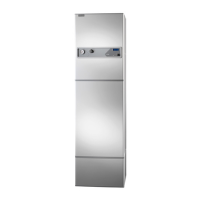General information for the installer
11
For Home Owners
FIGHTER 410P
Current regulations require the heating installation to
be inspected before it is commissioned. The inspec-
tion must be carried out by a suitably qualified person.
The above applies to installations with a closed expan-
sion vessel. If the heat pump or the expansion vessel
is replaced, the installation must be inspected again.
The heat pump should preferably be erected with its
back about 10 mm from an outside wall in a utility room
or similar, to minimise noise nuisance. If this is not
possible, avoid placing it against a wall behind a bed-
room or other room where noise may be a problem.
Irrespective of the placement the wall should be sound
insulated. NOTE! The distance between the heat pump
and the wall should be at least 10 mm.
Route pipes so they are not fixed to an internal wall
that backs on to a bedroom or living room.
An area of approximately 15 cm is required on the left
side of the heat pump, at the temperature and pres-
sure valve (145) to enable access to the valve.
NOTE! Since a waterfilled FIGHTER 410P weighs
roughly 440 kilos, the floor must stand such a weight.
The heat pump should be transported and stored ver-
tically in the dry.
The heat pump contains highly inflamma-
ble refrigerant. Special care should be
exercised during handling, installation,
service, cleaning and scrapping to avoid
damage to the refrigerant system and in
doing so reduce the risk of leakage.
Transport and storage
Handling
Erecting the heat pump
Inspection of the installation
The volume of the expansion vessel
(85) is 12 litres and it is pressurised as
standard to 0.5 bar (5 mvp). As a
result, the maximum permitted height
H between the vessel and the highest
radiator is 5 metres; see figure
If the standard initial pressure in the
pressure vessel is not high enough it
can be increased by adding air via the
valve in the expansion vessel. The initial pressure of
the expansion vessel must be stated in the inspection
document.
Any change in the initial pressure affects the ability of
the expansion vessel to handle the expansion of the
water. The maximum system volume excluding the
boiler is 285 litres at the above initial pressure.
Normal temperature levels in boiler or water heat-
er.
Temperatur
Utetemperatur
F
r
a
m
l
e
d
n
i
n
g
s
t
e
m
p
e
r
a
t
u
r
Min begränsning
20
20
Sommar Vinter
DUT
DUT: Dimensionerande utetemperatur
60
°C
°C
Vattenvattentemperatur "Normalfall"
Panntemperatur
50
40
30
Vattenvattentemperatur "Extra varmvatten"
Temperatuur
Välistemperatuur
P
e
a
l
e
v
o
o
l
u
t
e
m
p
e
r
a
t
u
u
r
Min. piirang
20
20
Suvi Talv
DUT
DUT: Dimensiooneritud
60
°C
°C
Veeboileri temperatuur "Normaaljuhus"
Katlatemperatuur
50
40
30
Veeboileri temperatuur"Lisa soe vesi"
Temperatur
Udetemperatur
F
r
e
m
l
ø
b
s
t
e
m
p
e
r
a
t
u
r
Min. begrænsning
20
20
Sommer Vinter
DUT
DUT: Dimensionerende udetemperatur
60
°C
°C
Vandvarmertemperatur “Normale forhold”
Kedeltemperatur
50
40
30
Vandvarmertemperatur “Ekstra varmt vand”
Temperatur
Außentemperatur
V
o
r
l
a
u
f
t
e
m
p
e
r
a
t
u
r
Unterer Grenzwert
20
20
Sommer Winter
DUT
60
°C
°C
Warmwasserspeichertemperatur "Normalbetrieb"
Heizkesseltemperatur
50
40
30
Warmwasserspeichertemperatur "Extra Warmwasser"
DUT: Norm-Temperatur
Temperature
Outside
temperature
F
l
o
w
t
e
m
p
e
r
a
t
u
r
e
Min. limit
20
20
Summer Winter
DUT
DUT: Design basis outside temperature
60
°C
°C
Hot watertemperature "Normal"
Boiler temperature
50
40
30
Hot water temperature "Extra hot water"
Temperatur
Außentemperatur
V
o
r
l
a
u
f
t
e
m
p
e
r
a
t
u
r
Unterer Grenzwert
20
20
Sommer Winter
DUT
DUT: Norm-Temperatur
60
°C
°C
Warmwasserspeichertemperatur "Normalbetrieb"
Heizkesseltemperatur
50
40
30
Warmwasserspeichertemperatur "Extra Warmwasser"
Temperatūra
Išorės temperatūra
I
š
e
i
n
a
n
t
i
t
e
m
p
e
r
a
t
ū
r
a
Žemiausia riba
20
20
Vasara Žiema
DUT
60
°C
°C
Karšto vandens rezervuaro temperatūra "Normalus funkcionavimas"
Šildymo katilo temperatūra
50
40
30
Karšto vandens rezervuaro temperatūra "Specialus karštas vanduo"
DUT: Normali temperatūra
LT
EST

